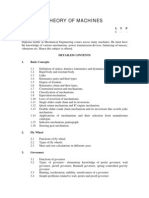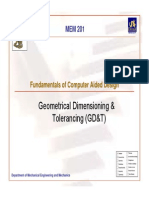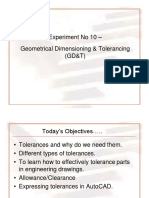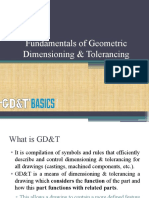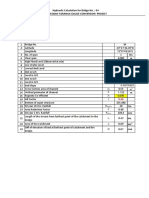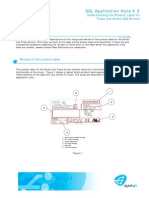Syllabus On GD&T - Stackup
Uploaded by
pultoshSyllabus On GD&T - Stackup
Uploaded by
pultoshGEOMETRIC DIMENSIONING AND TOLERANCING (GD&T) & STACK-UP ANALYSIS PROFESSIONAL COURSE
Lesson 1: Dimensions and Drawings Units of measurement Types of dimensioning Application of dimensions Dimensioning features Location of features
Definition of a dimension & examples. Definition of a tolerance & examples. Describe plus-minus tolerance Definition of the nominal of a dimension.
Direct tolerance method Tolerance expression Application Screw threads Gear and splines
2 hour
Lesson 2: Key Terms
Define a feature. Define a feature of size. The geometric dimensioning and tolerancing system Introduction to "ASME Y14.5M-1994." The three major benefits of geometric dimensioning and tolerancing. Define actual local size. 0.5 hour
Lesson 3: Modifiers and Symbols
Five types of geometric tolerance & characteristic. Name the fourteen geometric characteristic symbols & examples. The six common modifying symbols used in geometric tolerancing. Identify the parts of a feature control frame. Identify the ten additional symbols used in geometric tolerancing & examples. 1.5 hours
Lesson 4: GD&T Rules
Explain Rule #1. The three components of the envelope principle. How Rule #1 applies to a dimension. Describe the Rule #1 envelope boundary. Describe a limitation of Rule #1. List two ways Rule #1 can be overridden. Explain Rule #2 & examples Rule #2a & examples Problems & solutions. 1 hours
Lesson 5: GD&T Concepts
Describe a basic dimension & applications. Explain the concept of virtual condition & example Explain the concept of resultant condition & example Maximum Material Condition of a feature of size & example. Least Material Condition of a feature of size & example. Explain the concepts of inner boundary and outer boundary. Explain the concept of bonus tolerance. Calculate the amount of bonus tolerance permissible. Problems & solutions. 1.5 hours
Lesson 6: Flatness
Describe what flatness is. Describe the tolerance zone for a flatness control. Describe which modifiers can be used in a flatness control. Identify the three requirements in a flatness application. Describe how Rule #1 provides an indirect flatness control. Describe common applications for a flatness control. Describe how a flatness control can be inspected. Problems & solutions. 0.75 hours
Lesson 7: Straightness
Describe the difference between derived median line and axis. Describe the difference between derived median plane and centerplane. Describe straightness is. Describe the tolerance zone for straightness applied to a surface. Describe which modifiers can be used with a straightness control applied to a surface. Determine if a straightness control is applied to a surface or feature of size. Describe the tolerance zone for a straightness control applied to a feature of size. Describe how Rule #1 provides an indirect straightness control.
Recognize when a straightness control overrides Rule #1. Describe which modifiers can be used with a straightness control applied to a feature size. Calculate the amount of bonus in a straightness MMC application. Describe two common applications of a straightness control. Describe how a straightness control can be inspected. Problems & solutions. 1.25 hours
Lesson 8: Circularity
Describe what circularity is. Describe the tolerance zone for a circularity control. Describe which modifiers can be used in a circularity control. Describe how Rule #1 provides an indirect circularity control. List three conditions of a circularity application. Describe two common applications of a circularity control. Describe how a circularity control can be inspected. Problems & solutions. 0.5 hours
Lesson 9: Cylindricity
Describe what cylindricity is. Describe three requirements of a cylindricity control. Describe the tolerance zone for a cylindricity control. Describe which modifiers can be used in a cylindricity control. Describe how Rule #1 provides an indirect cylindricity control. List three conditions of a cylindricity application. Describe a common application of a cylindricity control. Describe how a cylindricity control can be inspected. Problems & solutions. 0.75 hours
Lesson 10: Planar Datums
Describe the datum system. List three benefits of the datum system. Define an implied datum. Define a datum. Define a datum feature. Define a true geometric counterpart. Define a datum feature simulator. Define the datum feature symbol. Describe four ways to specify a planar datum. Describe how to reference datums in a feature control frame. Describe a datum reference frame. List six degrees of part freedom in space. Describe coplanar datum features. 0.5 hour
Lesson 11: Datum Targets
Describe datum targets. List three situations where datums targets should be used. Recognize the datum target symbol. State when a datum target specification is on the front or back surface in a view on a drawing. Describe why basic dimensions are used to locate datum targets. Draw a simulated gage for a datum target point specification. Draw a simulated gage for a datum target line specification. Draw a simulated gage for a datum target area specification. 0.5 hour
Lesson 12: Orientation Controls
Describe when to use each orientation control. Describe the common tolerance zones for orientation controls. List two requirements for orientation controls. List two indirect orientation controls. 0.25 hour
Lesson 13: Perpendicularity
List two common tolerance zones for a perpendicularity control. List two requirements of a perpendicularity control. Describe the tolerance zone for a perpendicularity control applied to a surface. Explain how a perpendicularity control applied to a surface affects its flatness. Explain the effect of applying a perpendicularity control to a feature of size. Explain how to specify a cylindrical tolerance zone for a perpendicularity control. Explain the tolerance zone when a perpendicularity control is applied to a cylindrical feature of size. Explain the effects of a MMC modifier in a perpendicularity control. Describe the gage for an application using a perpendicularity control applied at MMC. Describe two common applications for a perpendicularity control. Problems & solutions. 0.75 hours
Lesson 14: Angularity
List two common tolerance zones for an angularity control. List two requirements of an angularity control. Describe the tolerance zone for an angularity control applied to a surface. Explain how an angularity control applied to a surface affects its flatness. Explain the effect of applying an angularity control to a feature of size. Explain how to specify a cylindrical tolerance zone for an angularity control. Explain the tolerance zone when an angularity control is applied to a cylindrical feature size. Describe two applications for angularity. Explain how an angularity control can be inspected. Problems & solutions. 0.75 hours
Lesson 15: Parallelism
List two common tolerance zones for a parallelism control. List two requirements of a parallelism control. Describe the tolerance zone for a parallelism control applied to a surface. Explain how a parallelism control applied to a surface affects its flatness. Explain the effect of applying a parallelism control to a feature of size. Describe how to specify a cylindrical tolerance zone for a parallelism control. Interpret the effects of specifying the tangent plane modifier with a parallelism control. Describe two applications for parallelism. Explain how a parallelism control can be inspected. Problems & solutions. 0.75 hours
Lesson 16: Position - RFS/MMC/LMC
List three conditions that apply when a tolerance of position control is applied at RFS. Describe two common tolerance zone shapes for a tolerance of position control at RFS. Calculate the worst-case boundary for a feature of size controlled with tolerance of position at RFS. List three conditions that exist when an MMC modifier is used in a tolerance of position application. Describe the tolerance zone in tolerance of position MMC applications. Calculate the virtual condition of a feature of size controlled with a tolerance of position MMC. Calculate the amount of bonus tolerance permissible for a tolerance of position application. Calculate the amount of datum shift available in a coaxial diameter tolerance of position application. Describe when a tolerance of position control should use the LMC modifier. Describe how bonus tolerance is calculated in an LMC position application. Describe four common applications for a tolerance of position control. Describe how a tolerance of position control applied at RFS can be inspected. Define the term "cartoon gage." Describe how a tolerance of position control applied at MMC can be inspected. Composite position tolerance Multiple single segments TOP. 1.25 hours
Lesson 17: Concentricity
Describe a median point. Describe the term "concentricity." Describe the tolerance zone for a concentricity control. List three requirements of a concentricity control. Interpret a concentricity control application. Describe one difference between concentricity and tolerance of position (RFS). Describe one common application for concentricity. Describe how a concentricity control can be inspected. Problems & solutions. 0.5 hours
Lesson 18: Symmetry
Describe the term "symmetry." Describe the tolerance zone for a symmetry control. Interpret a symmetry control application. Describe one difference between symmetry and tolerance of position (RFS). Describe one common application for symmetry. Describe how a symmetry control can be inspected. Problems & solutions. 0.5 hours
Lesson 19: Circular Runout
Describe what runout is. List two types of runout controls. List three ways a datum axis can be specified for a runout control. Explain what circular runout is. Describe the tolerance zone for a circular runout control (applied to a diameter). Describe how circular runout can be inspected. Describe how circular runout is a composite control. Determine the maximum amount of axis offset from a circular runout control. Interpret a circular runout application. Describe two common applications for circular runout. Problems & solutions. 0.75 hours
Lesson 20: Total Runout
Describe what total runout is. List two requirements of a total runout control. Describe the tolerance zone for a total runout control (applied to a diameter). Describe how total runout is verified. Describe how total runout is a composite control. Determine the maximum amount of axis offset from a total runout control. Describe two similarities between circular and total runout. Describe two differences between circular and total runout. Describe two common applications for total runout. Problems & solutions 0.75 hours
Lesson 21: Introduction to Profile
Describe how profile can be a related feature control or a form control. Describe the term "profile." Describe the term "true profile." Describe the term "profile control." Describe the four characteristics that profile can control. Describe the difference in tolerance zones for a profile of a surface and a profile of a line control. Recognize the four types of profile tolerance zone specifications. Describe a bilateral tolerance zone for a profile control. Describe a unilateral tolerance zone for a profile control. Recognize the symbol for "between." Recognize the symbol for "all around." 0.5 hours
Lesson 22: Profile of a Surface
List four part characteristics profile of a surface can be used to control. List two requirements of profile of a surface applied to a surface. Describe the part characteristics being controlled when a profile of a surface is used to control a surface location. List two requirements of a profile of a surface control applied to a polygon. Describe the part characteristics being controlled when profile of a surface is applied polygon. List two requirements of a profile of a surface control applied to a cone. Describe the part characteristics being controlled when profile of a surface is applied conical feature. List two requirements of profile of a surface applied to coplanar surfaces. Describe the part characteristics being controlled when profile of a surface is applied coplanar surfaces. Describe two common applications for a profile of a surface control. Describe how a profile of a surface control can be inspected. Problems & solutions. 0.75 hours
Lesson 23: Profile of a Line
List two requirements of a profile of a line control. Describe the tolerance zone for a profile of a line control. Describe how profile of a line is view dependent. Interpret a multiple single-segment profile application. Interpret an application with a profile of a line control used with coordinate tolerances. Describe two common applications for a profile of a line control. Describe how profile of a line can be inspected. Problems & solutions. 0.5 hours
Lesson 24: Stackup Analysis
Introduction to stackup analysis. Types of stackup analysis. Converting Plus/ Minus Dimension tolerance to equal bilaterally tolerance Dimension. Floating-Fastener & Fixed-Fastener formulas & considerations Worst case tolerance Stackups Statistical tolerance Stackups Fit classification Stack-up analysis for a given assembly 1.0 hours
You might also like
- LS 25S Parts Manual Generation I Model PDF100% (2)LS 25S Parts Manual Generation I Model PDF76 pages
- Measuring Principles For Geometrical Tolerances: Standard STD 112-0004ENo ratings yetMeasuring Principles For Geometrical Tolerances: Standard STD 112-0004E38 pages
- Chapter 1: Fundamentals of Robotics History: Important Points and SummaryNo ratings yetChapter 1: Fundamentals of Robotics History: Important Points and Summary16 pages
- Interpret The Flatness Control. - Interpret The Straightness Control. - Interpret The Circularity Control. - Interpret The Cylindricity ControlNo ratings yetInterpret The Flatness Control. - Interpret The Straightness Control. - Interpret The Circularity Control. - Interpret The Cylindricity Control23 pages
- Our Official Android App - REJINPAUL NETWORK FromNo ratings yetOur Official Android App - REJINPAUL NETWORK From1 page
- Department of Mechanical Engineering Me6504 Engineering Metrology and Measurement Question BankNo ratings yetDepartment of Mechanical Engineering Me6504 Engineering Metrology and Measurement Question Bank7 pages
- Statics and Strength of Materials Intro Beam AnalysisNo ratings yetStatics and Strength of Materials Intro Beam Analysis69 pages
- 9c - Geometric Dimension Ing & Tolerancing (Part 3)100% (2)9c - Geometric Dimension Ing & Tolerancing (Part 3)53 pages
- Numerical Methods: By: Jeziel C. Suniel, EceNo ratings yetNumerical Methods: By: Jeziel C. Suniel, Ece48 pages
- LAB #2b Testing of Hardened Concrete: Due: March 25/27/29No ratings yetLAB #2b Testing of Hardened Concrete: Due: March 25/27/292 pages
- Similitude Analysis of Concrete Scaled Bridge Columns ForNo ratings yetSimilitude Analysis of Concrete Scaled Bridge Columns For7 pages
- Experiment No 10 - Exercises in Preparation of Detailed Production DrawingsNo ratings yetExperiment No 10 - Exercises in Preparation of Detailed Production Drawings29 pages
- MATH1520 Chapter 5 (Applications of Differentiation)No ratings yetMATH1520 Chapter 5 (Applications of Differentiation)43 pages
- Unit 4 - Form Control and Its ApplicationsNo ratings yetUnit 4 - Form Control and Its Applications36 pages
- Cylindricity and Its Measurement by Dean J.W. Dawson Limited P.O. Box 36, 2 New Star Road Leicester LE4 7JQNo ratings yetCylindricity and Its Measurement by Dean J.W. Dawson Limited P.O. Box 36, 2 New Star Road Leicester LE4 7JQ7 pages
- Fundamentals of Geometric Dimensioning & TolerancingNo ratings yetFundamentals of Geometric Dimensioning & Tolerancing109 pages
- Multiple Models Approach in Automation: Takagi-Sugeno Fuzzy SystemsFrom EverandMultiple Models Approach in Automation: Takagi-Sugeno Fuzzy SystemsNo ratings yet
- Movement Equations 2: Mathematical and Methodological SupplementsFrom EverandMovement Equations 2: Mathematical and Methodological SupplementsNo ratings yet
- Planar Linkage Synthesis: A modern CAD based approachFrom EverandPlanar Linkage Synthesis: A modern CAD based approachNo ratings yet
- Monocrystalline Module: Maximum Power OutputNo ratings yetMonocrystalline Module: Maximum Power Output2 pages
- Hydraulic Calculation For Bridge No.:-34 Mahesana-Taranga Gauge Conversion ProjectNo ratings yetHydraulic Calculation For Bridge No.:-34 Mahesana-Taranga Gauge Conversion Project3 pages
- AC/DC LED Ballasts :: ROAL Living EnergyNo ratings yetAC/DC LED Ballasts :: ROAL Living Energy3 pages
- Unit 4 Governing Equations of Heat Conduction: StructureNo ratings yetUnit 4 Governing Equations of Heat Conduction: Structure45 pages
- Eec 324 Practice Questions With AnswersNo ratings yetEec 324 Practice Questions With Answers11 pages
- UA SRG JEE Adv. 24 Assignment Result PCM (12,13 - March - 2024)No ratings yetUA SRG JEE Adv. 24 Assignment Result PCM (12,13 - March - 2024)3 pages
- 32.power System Study-Sc, RC & Dynamic Testing100% (2)32.power System Study-Sc, RC & Dynamic Testing136 pages
- 111 112 103 104 110 102 U V W EGR Valve MotorNo ratings yet111 112 103 104 110 102 U V W EGR Valve Motor1 page
- (Supplements To The Study of Time 1) Fraser, Fraser Julius Thomas - Time and Time Again - Reports From A Boundary of The Universe-Brill (2007)No ratings yet(Supplements To The Study of Time 1) Fraser, Fraser Julius Thomas - Time and Time Again - Reports From A Boundary of The Universe-Brill (2007)448 pages
- Blood Bank Management System: Link To The Video PresentationNo ratings yetBlood Bank Management System: Link To The Video Presentation33 pages
- Measuring Principles For Geometrical Tolerances: Standard STD 112-0004EMeasuring Principles For Geometrical Tolerances: Standard STD 112-0004E
- Chapter 1: Fundamentals of Robotics History: Important Points and SummaryChapter 1: Fundamentals of Robotics History: Important Points and Summary
- Interpret The Flatness Control. - Interpret The Straightness Control. - Interpret The Circularity Control. - Interpret The Cylindricity ControlInterpret The Flatness Control. - Interpret The Straightness Control. - Interpret The Circularity Control. - Interpret The Cylindricity Control
- Department of Mechanical Engineering Me6504 Engineering Metrology and Measurement Question BankDepartment of Mechanical Engineering Me6504 Engineering Metrology and Measurement Question Bank
- Statics and Strength of Materials Intro Beam AnalysisStatics and Strength of Materials Intro Beam Analysis
- 9c - Geometric Dimension Ing & Tolerancing (Part 3)9c - Geometric Dimension Ing & Tolerancing (Part 3)
- LAB #2b Testing of Hardened Concrete: Due: March 25/27/29LAB #2b Testing of Hardened Concrete: Due: March 25/27/29
- Similitude Analysis of Concrete Scaled Bridge Columns ForSimilitude Analysis of Concrete Scaled Bridge Columns For
- Experiment No 10 - Exercises in Preparation of Detailed Production DrawingsExperiment No 10 - Exercises in Preparation of Detailed Production Drawings
- MATH1520 Chapter 5 (Applications of Differentiation)MATH1520 Chapter 5 (Applications of Differentiation)
- Cylindricity and Its Measurement by Dean J.W. Dawson Limited P.O. Box 36, 2 New Star Road Leicester LE4 7JQCylindricity and Its Measurement by Dean J.W. Dawson Limited P.O. Box 36, 2 New Star Road Leicester LE4 7JQ
- Fundamentals of Geometric Dimensioning & TolerancingFundamentals of Geometric Dimensioning & Tolerancing
- Multiple Models Approach in Automation: Takagi-Sugeno Fuzzy SystemsFrom EverandMultiple Models Approach in Automation: Takagi-Sugeno Fuzzy Systems
- Experimental Mechanics of Solids and StructuresFrom EverandExperimental Mechanics of Solids and Structures
- Power System Wide-area Stability Analysis and ControlFrom EverandPower System Wide-area Stability Analysis and Control
- Movement Equations 2: Mathematical and Methodological SupplementsFrom EverandMovement Equations 2: Mathematical and Methodological Supplements
- Mechanics Using Matlab: An Introductory GuideFrom EverandMechanics Using Matlab: An Introductory Guide
- Worked Examples in Mechanics of Machines using MATLABFrom EverandWorked Examples in Mechanics of Machines using MATLAB
- Planar Linkage Synthesis: A modern CAD based approachFrom EverandPlanar Linkage Synthesis: A modern CAD based approach
- Applied Metrology for Manufacturing EngineeringFrom EverandApplied Metrology for Manufacturing Engineering
- Hydraulic Calculation For Bridge No.:-34 Mahesana-Taranga Gauge Conversion ProjectHydraulic Calculation For Bridge No.:-34 Mahesana-Taranga Gauge Conversion Project
- Unit 4 Governing Equations of Heat Conduction: StructureUnit 4 Governing Equations of Heat Conduction: Structure
- UA SRG JEE Adv. 24 Assignment Result PCM (12,13 - March - 2024)UA SRG JEE Adv. 24 Assignment Result PCM (12,13 - March - 2024)
- (Supplements To The Study of Time 1) Fraser, Fraser Julius Thomas - Time and Time Again - Reports From A Boundary of The Universe-Brill (2007)(Supplements To The Study of Time 1) Fraser, Fraser Julius Thomas - Time and Time Again - Reports From A Boundary of The Universe-Brill (2007)
- Blood Bank Management System: Link To The Video PresentationBlood Bank Management System: Link To The Video Presentation
















